FACTORS USED IN THE COMPARISON
First, the ten pear varieties compared are in alphabetic order not order of preference. It is almost impossible to recommend a particular variety from the ten described below because each person will have different needs and garden situations.
There are many heritage varieties available which are not mentioned in the list below and the reason is their poor disease resistance. In their day they may well have been grown with minimal problems but pests and diseases, especially, have evolved over time to make older varieties a prime target. For those who prefer an ornamental pear tree, we would recommend Pyrus Pashia.
POLLINATION BETWEEN VARIETIES OF PEAR TREES
One of the key factors when buying a pear tree is pollination. Only a few pear trees are reliably self-fertile, several are partially self-fertile and the majority as self-sterile. For a self-sterile pear tree, it is absolutely essential to have a compatible pear tree of another variety nearby if pollination (and therefore fruit production) is to occur. Partially self fertile varieties are likely to produce a fruit crop when no other variety is nearby but fruit production will be increased, to differing degrees, when a suitable nearby pollination partner is nearby
The definition of a “nearby pollination partner” is variable because it depends on a variety of factors including the distance between two trees, the layout of the land between them, wind strength, temperatures at the relevant time of year and many other factors. In suburban areas and many urban areas it is quite possible that there will be a suitable pollination partner within reach most years, that is the nature of British garden in those areas but nothing is guaranteed.
Bees do fly considerable distance in spring to find sources of nectar but the precise distance is variable. We will stick our necks out and say that a suitable pollination partner within a quarter of a mile is likely to be sufficient but only personal experience can prove this in your particular garden / allotment. A distance of two miles is also often sufficient but far less reliable.
The detailed description of every one of the varieties described below contains a list of suitable pollination partners.
BETH
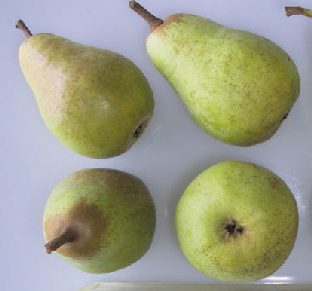
POLLINATION: Self sterile (see main article for pollination partners)
TASTE AND TEXTURE: Sweet, juicy, smooth.
REGULARITY OF CROPPING: Very regular.
SPECIAL FEATURES: Regularly produces an early season crop of tasty pears.
The Beth pear tree can be summed up in two key phrases, early in the year to fruit and a superb flavour. It might not be your choice for the first pear tree you buy but it must come high on the list for a second pear tree. Most pear trees produce fruit in October but Beth reliably fruits in early September …. Click here for the full article on the Beth pear tree.
BEURRE BOSC

POLLINATION: Self sterile (see main article for pollination partners)
TASTE AND TEXTURE: Soft and buttery, lots of russet skin
REGULARITY OF CROPPING: Regular, good crop.
SPECIAL FEATURES: None
The Beurre Bosc pear variety produces very tasty pears which can be somewhat variable in texture. When grown in the UK against a sunny wall the texture is soft and melting. In cooler situations the pear becomes slightly crisper but eminently eatable. Although preferring warm conditions it ….. Click here for the full article on the Beurre Bosc pear tree.
CONCORDE
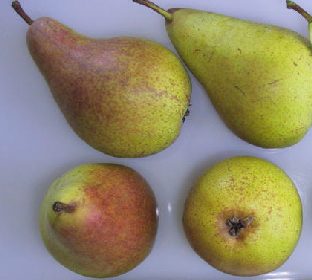
POLLINATION: Self-fertile but does even better with a suitable pollination partner (see main article for pollination partners)
TASTE AND TEXTURE: A full pear flavour and aroma. The texture is smooth with a slight crispness. Lots of juice. Overall excellent.
REGULARITY OF CROPPING: Regular, good crop.
SPECIAL FEATURES: One of the few recently bred pear trees that are available commercially. Easy to grow, tolerant of soil conditions, ideal for the beginner. Produces fruit early in its life.
This relatively new variety takes much of the excellent taste characteristics of Doyenne Du Comice and combines them with the regular and vigorous cropping features of Conference. Although classified as self-fertile there is no doubt that Concorde benefits greatly from a suitable nearby pollinating partner ….. Click here for the full article on the Concorde pear tree.
CONFERENCE
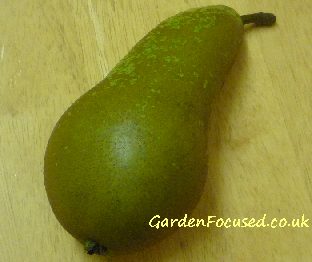
POLLINATION: Self-fertile but does even better with a suitable pollination (see main article for pollination partners)
TASTE AND TEXTURE: Sweet and soft when ripe.
REGULARITY OF CROPPING: Regular and crops well.
SPECIAL FEATURES: An excellent all-rounder for growing in the UK. Will produce a crop on its own.
It is the most widely grown pear tree variety in the UK because of its cropping reliability, good disease resistance and self-fertility. Taste and texture are also good. ….. Click here for the full article on the Conference pear tree.
DOYENNE DU COMICE
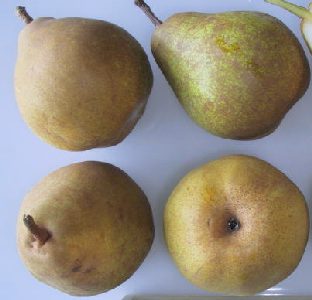
POLLINATION: Self sterile (see main article for pollination partners)
TASTE AND TEXTURE: Sweet, deep pear flavour, soft and melting texture
REGULARITY OF CROPPING: Good
SPECIAL FEATURES: Top quality taste and texture.
If you want a slice of pear tree history but at the same time want top quality eating pears then Doyenne du Comice should be top on your list. It is a typical French style pear with fruits that almost melt in your mouth. The flavour is everything you could want from a pear, sweet but full of real fruit flavour ….. Click here for the full article on the Doyenne du Comice pear tree.
GORHAM
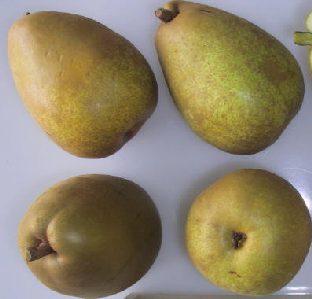
POLLINATION: Partially self-fertile (see main article for pollination partners)
TASTE AND TEXTURE: Sweet juicy and smooth texture
REGULARITY OF CROPPING: Regular with good crops
SPECIAL FEATURES: As good as Williams Bon Chretien but with better disease resistance.
A highly under-rated variety of pear, Gorham is, in reality, an “improved” version of the Williams / Bartlett pear. The flavour of the two varieties is almost indistinguishable but what makes Gorham stand out is its high resistance to scab. It also has good resistance to mildew ….. Click here for the full article on the Gorham pear tree.
PERRY PEAR TREES
Perry pear trees are growing in popularity as more and more people brew their own alcoholic drinks. It’s far easier and quicker to make pear cider (more correctly known as Perry) than wine. Perry is simple the juice of pears turned into an alcoholic drink in a similar way as cider. To recommend one pear tree for this purpose is almost impossible because they do ….. Click here for the full article dedicated to popular Perry pear tree varieties available in the UK.
WILLIAMS BON CHRETIEN
POLLINATION: Self-fertile but does even better with a suitable pollination partner (see main article for pollination partners)
TASTE AND TEXTURE: Sweet juicy and smooth texture
REGULARITY OF CROPPING: Regular with good crops
SPECIAL FEATURES: An excellent all-rounder for eating and cooking.
The taste of Williams Bon Chretien pears is, overall, sweet but there is a background hint of acidity. There is a slight musk element in the aroma. The flesh is juicy and soft when ripe. One benefit of Williams pears is that they cook very well. The majority of the world production of tinned pears are of the Williams variety. ….. Click here for the full article on the Williams Bon Chretien pear tree.
WINTER NELIS
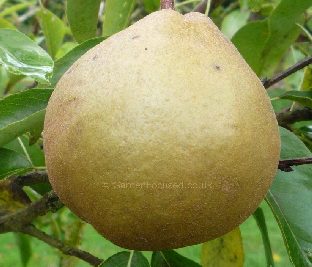
POLLINATION: self-sterile (see main article for pollination partners)
TASTE AND TEXTURE: Sweet and juicy with fine texture.
REGULARITY OF CROPPING: Good regularity.
SPECIAL FEATURES: Excellent storage properties, can be eaten well into January
Winter Nelis, when grown in the UK, is the best of the winter pears overall. When picked in October it has the ability to be stored into January. Because the weather has started to turn cooler in October no special storage facilities are required other than a garage or shed. ….. Click here for the full article on the Winter Nelis pear tree.
TOP THREE PEAR VARIETIES FOR THE UK
We have selected the three varieties of pear tree below not only because they are excellent in their own right but they will also be excellent pollination partners and produce pears over a relatively long period of time.
Our choice for early pears would be Beth, then mid-season would be Concorde and finally for later in the season Winter Nelis. These three varieties should provide you with eating pears over a two month period and if you store Winter Nelis correctly you may well extend that by a month or more.
COMMENTS / QUESTIONS LEFT BY OUR READERS
| Date: 24 July 2019 | From: David |
| QUESTION: I have a 40 foot south facing wall and would like grow espalier pears. Your top 3 varieties seem to be unsuitable for espalier cultivation. Can you recommend varieties that can be grown as espaliers?
ANSWER: The article I wrote on 10 recommended varieties of pear trees lists them in alphabetic order not in list of being the best. Maybe I have listed the top three elsewhere but I can’t see that. Two well established favourites which are fine for espalier growth are Concorde and Conference. Conference is fully self-fertile and Concorde is partially to nearly self fertile. Conference produces a crop slightly later than Concorde so this would spread the cropping season if both were planted. I would go for a mix of Conference and Concorde. |
|
WHY NOT LEAVE YOUR QUESTION / COMMENTS ABOUT THIS PAGE?
ENTER THEM BELOW. EMAIL ADDRESS IS OPTIONAL.
YOUR COMMENTS WILL BE ADDED ABOVE WITHIN A FEW HOURS.
[contact-form-7 id=”1882″ title=”Contact form 1″]

Rootstocks and Size
Guide to Pollination
Planting
Care Plan
Pruning Pear Trees
Harvest and Storage
Pests and Disease
Top ten pear varieties
Buying – Price Comparison
COMPARISON OF TOP TEN PEAR TREE VARIETIES
By David Marks
This article compares the top ten pear varieties commonly grown in the UK. Each variety can be researched in more detail by clicking of the pear variety name for a more comprehensive description.
At the end of this article we suggest three varieties which will pollinate each other very successfully and provide a lengthy cropping season for the average UK garden.